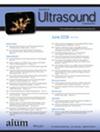Ventricular Free Wall and Septal Wall Displacement of the Fetal Heart
Abstract
Objective
The purpose of this study was to measure the systolic displacement of the free and septal walls of the right (RV) and left (LV) ventricles using speckle tracking analysis in normal fetuses and those with cardiac abnormalities.
Methods
Two-hundred fetuses between 20 and 40 weeks of gestation were examined in which the 4-chamber view (4CV) of the fetal heart was imaged. Speckle tracking analysis of the RV and LV was used to measure the length of displacement between end-diastole and end-systole for each of 24 segments located on the free and septal walls from the base to the apex of each ventricle. The mean displacement length was computed for the base (segments 1–8), mid-chamber (segments 9–16), and the apex (segments 17–24) of the RV and LV free walls (RVfw, LVfw) and septal walls (RVsw, LVsw). Fractional polynomial regression analysis was used to compute the mean equation for the base, mid-chamber, and apex displacement lengths for the RV and LV free walls and septal walls using gestational age as the independent variable. The Kruskal–Wallis test with a Bonferroni correction was used to compare the mean values from the base, mid-chamber, and apex segments between the RVfw versus RVsw, LVfw versus LVsw, RVfw versus LVfw, and RVsw versus LVsw. In addition, the ultrasound program provided a graphic of the systolic segment length of the RV and LV free walls and septal walls. Four examples of cardiac pathology were used to illustrate abnormal free and septal wall segment displacement.
Results
The mean segment end-systolic displacement lengths for the RVfw (base and mid-chamber), and LVfw (base, mid-chamber, and apex) increased with gestational age. However, The RVsw and LVsw segment lengths did not increase or increased minimally as a function of gestational age. The displacement lengths for the RVfw versus RVsw and LVfw versus LVsw were greater for the free wall than the septal wall for the base, mid-chamber, and apex. When comparing the RV with the LV, the segment lengths for the RVfw were significantly greater than the LVfw for the base. The segment lengths were significantly greater for the LVsw than the RVsw for the base, mid-chamber, and apex. The LVsw segments moved inward toward the LV chamber for the mid-chamber and apex. For the RVsw, the segment lengths moved between both the RV and LV chamber during systole. Four pathological cases graphically illustrated abnormal movement of the RVfw, LVfw, RVsw, and LVsw.
Conclusion
Speckle tracking analysis enabled quantitation of the systolic ventricular free wall and septal wall segment displacement as well as a graphical display of displacement that can be used to identify pathological changes when abnormal cardiac function is present.

 求助内容:
求助内容: 应助结果提醒方式:
应助结果提醒方式:


